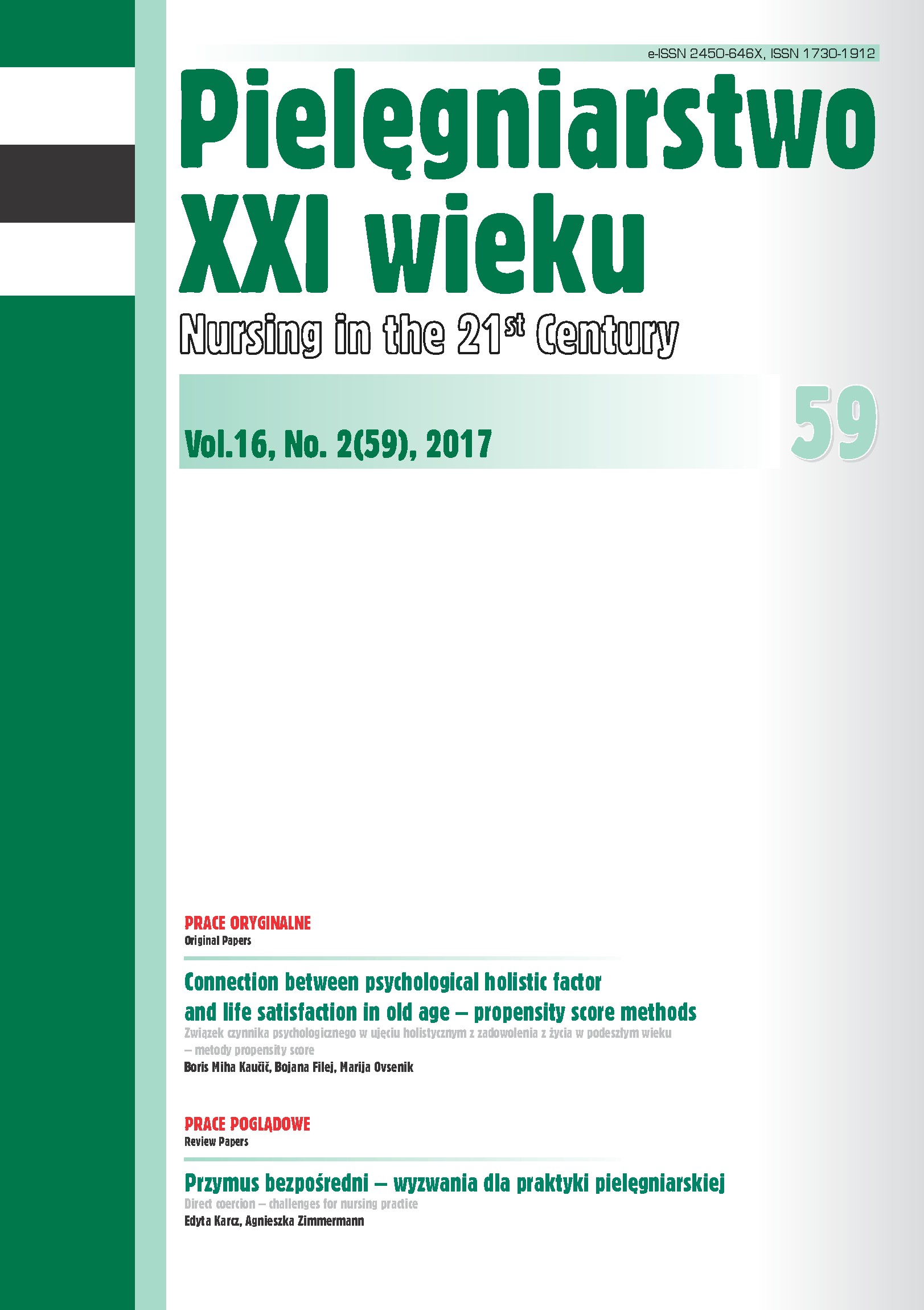Direct coercion – challenges for nursing practice
DOI:
https://doi.org/10.1515/pielxxiw-2017-0020Keywords:
coercion, patient, legislation, nursing practice, informed consentAbstract
DIRECT COERCION – CHALLENGES FOR NURSING PRACTICE
Introduction. Direct coercion is a part of medical intervention in which the patient’s autonomy as a basic human right is limited. In clinical practice, there are situations in which the use of coercion is indeed necessary to protect the patient and his/her environment against the effects of growing aggression. A very important element of action in such cases is to ensure the safety of both the patient through professional care, and of the personel executing the coercive measure.
Aim. The aim of this thesis is to analyze the legal scope and applicability of coercive measures in nursing practice.
Method. The exegesis of a legal text was used, which allows to present the legal conditions and rules of conduct in case of using direct coercion in psychiatric institutions and non-psychiatric units.
Conclusions. Regardless of the type of institution, the decision to use direct coercion should be carefully considered in terms of both the patient’s good and safety. This is a unique operation. It should be done in accordance with legal guidelines in this regard, what significantly determines the employees’ safety.
References
1. Konstytucja Rzeczypospolitej Polskiej z dnia 2 kwietnia 1997 r. (Dz. U. Nr 78, poz. 483 z późn. zm.).
2. Pużyński J, Wciórka J. Klasyfikacja zaburzeń psychicznych i zaburzeń zachowania w ICD-10. Opisy kliniczne i wskazówki diagnostyczne. Kraków: Vesalius; 2000, wyd. 2.
3. Heitzman J. Postępowanie w stanach dysforycznych i zaburzeniach kontroli impulsów. Psychiatria Polska. 2007; 6: 926-931.
4. Kokoszka A. Postępowanie w stanach naglących. W: Bilikiewicz A, Pużyński S, Rybakowski J, Wciórka J. (red.). Psychiatria. Wrocław: Elsevier Urban i Partner; Tom 3. 2003, s.321-323.
5. Ustawa z dnia 19 sierpnia 1994 r. o ochronie zdrowia psychicznego (tekst jednolity Dz. U. z 2016 poz. 546).
6. Rozporządzenie Ministra Zdrowia z dnia 28 czerwca 2012 r. w sprawie sposobu stosowania i dokumentowania zastosowania przymusu bezpośredniego oraz dokonywania oceny zasadności jego zastosowania (Dz. U. z 2012 r., poz. 740).
7. Ustawa z dnia 5 grudnia 2008 r. o zapobieganiu oraz zwalczaniu zakażeń i chorób zakaźnych u ludzi (tekst jednolity Dz. U. z 2013 r. poz. 947 z późn. zm.).
8. Gałecki P, Bobińska K, Eichstaedt K. Ustawa o ochronie zdrowia psychicznego. Komentarz. Warszawa; Wolters Kluwer, wyd. 2. 2016.
9. Karkowska D. Stosowanie przymusu bezpośredniego wobec pacjentów z zaburzeniami psychicznymi. http://www.prawoizdrowie.pl//, data wejścia: 28.01.2017 r.
10. Augustynowicz A, Wrześniewska-Wal I. Stosowanie przymusu bezpośredniego przez personel medyczny w procesie diagnozowania i terapii małoletnich pacjentów. Pediatria Polska. 2013; 88: 206-212.
11. Ustawa z dnia 5 grudnia 1996 r. o zawodach lekarza i lekarza dentysty (tekst jednolity z 2015 Dz. U. z 2015 poz. 464 z późn. zm.).
12. Ustawa z dnia 6 czerwca 1997 r. Kodeks karny (tekst jednolity Dz. U z 2016 poz. 1137).
13. Augustynowicz A, Wrześniewska-Wal I, Czerw A. Stosowanie środków przymusu bezpośredniego w podmiotach sprawujących opiekę nad osobami w wieku podeszłym. Family Medicine & Primary Care Review. 2016; 1: 69-73.
14. Wilczek-Rużyczka E. Komunikowanie się z chorym psychicznie. Lublin; Wydawnictwo Czelej. 2007.
15. Golec S, Kokoszka A. Postępowanie w nagłych zaburzeniach psychicznych. Kraków: Wydawnictwo Medycyna Praktyczna. 1995, s. 126-129.
16. Danzer G, Rieger SM. Improving medication adherence for severely mentally ill adults by decreesing coercion and increasing cooperation. Bulletin of Menninger Clinic. 2016 Winter. 2016; 80 (1):30-48.
17. Norvoll R, Hem MH, Pedersen R. The Role of Ethics in Readucing and Improving the Quality of Coercion in Mental Health Care. HEC Forum.1 March 2017. 29 (1): 59-74.
Published
Issue
Section
License
Copyright (c) 2017 Authors

This work is licensed under a Creative Commons Attribution-NonCommercial-NoDerivatives 3.0 Unported License.




